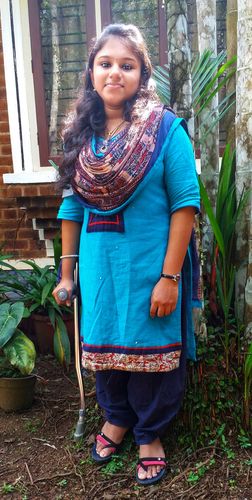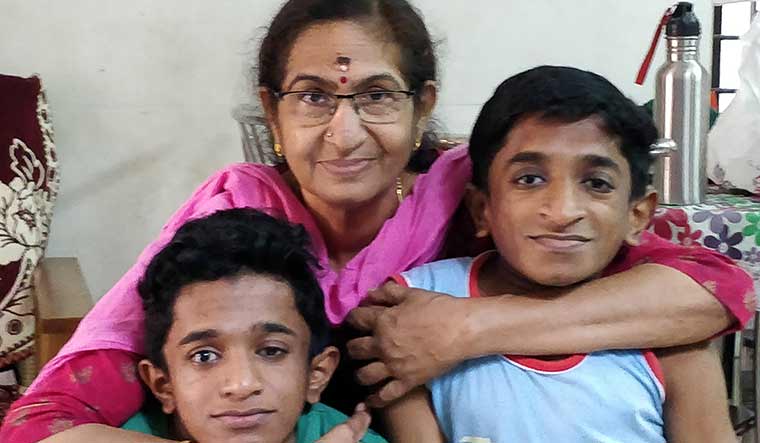Sandra Somanath’s troubles began when she was barely eight months old. The toddler had a fracture in her thighbone while playing with her grandmother on her bed. Since then, there have been several such painful instances. “I had one when I was three years old, then at four, seven, 10, 11, 19 and at 20 years of age,” says Sandra, a second-year student of medicine at T.D. Medical College, Alappuzha, counting the number of times she has had a fracture.
Each time her bones gave in, the 21-year-old says she was in the middle of a routine activity—walking, playing and, in one instance, merely standing up after finishing a classical music recital at school. While her first fracture was treated simply with traction (the practice of slowly and gently pulling on a fractured or dislocated body part to stabilise and realign it), rest of the times she had to get bone implants to fix the fractures. At 11, she had a spine surgery, too. “In between these fractures, I have also been confined to the bed several times because of the pain in my legs that would come suddenly, or because I had some minor injuries,” she recalls.
What ails Sandra is known as osteogenesis imperfecta (OI) or brittle bone disease, a rare genetic disorder that causes bones to break frequently, often from little or no apparent trauma. For many of those suffering from OI, a cough, sneeze, sound or even tapping on a keyboard can cause enough trauma for a bone to snap.
“The disease is the result of a random genetic mutation. We now know that there are 12 types of OI,” says Dr Manoj Padman, director, Centre for Paediatric Orthopaedics and Disabilities, New Delhi. “The mutation is present in the collagen gene. Collagen is what binds the bone cells, and its deficiency or inferior quality as in the case of OI patients is what renders the bones brittle and prone to breaking frequently.”
Padman says that the severity of the disease varies depending on the type of OI, ranging from intrauterine which is fatal, to ones where patients will have suffered up to 200 fractures until their teens, to milder versions where only certain limbs are affected, as in the case of Sandra where only her thighbone is affected. “Usually the manifestation starts when the baby starts walking, and there is load on the legs, so from the age of one onwards,” says Padman. “Fractures will affect the lower limbs and the spine mostly, but upper limbs may also be affected.”
Collagen deficiency also leads to teeth problems (dentinogenesis imperfecta) and blue sclera (blue colour caused by the thinness and transparency of the collagen fibres of the sclera, allowing the veins in the underlying tissue to show through), says Padman. Such patients may also have muscle weakness, loose joints (joint laxity) and skeletal malformations.
“The disorder occurs in one in 20,000 children in the world. However, we don’t have the exact numbers for its prevalence in India,” says Dr Neerja Gupta, clinical geneticist, All India Institute of Medical Sciences, New Delhi.
OI has no cure, says Padman. Current treatment comprises administering bisphosphonates (class of drugs that prevents the loss of bone density, used to treat osteoporosis and similar diseases). “Cyclical bisphophonate therapy is the gold standard when it comes to treating OI,” says Padman. “This is given until the child’s growth is completed. The other arm of the treatment is surgical straightening, stabilising and putting rods within the bone.” Telescopic intramedullary rods that expand and elongate within the bone as the child grows are used in such cases, he adds. “Sometimes I do get patients whose fractures have been treated as normal fractures. Due to recurrent fractures and not getting the right drugs and implants, bone deformity occurs in such children,” he says.
Gupta says that various research groups are working on developing different forms of treatment for OI such as blockade of certain proteins and gene therapy. “Genetic testing helps in establishing the etiology (the cause, set of causes, or manner of causation of a disease) and preventing recurrences in future pregnancy,” she says. “Clinical geneticists and orthopaedic surgeons have a key role in treatment of the disease.”
Latha Nair, 64, founder of the Thiruvananthapuram-based NGO Amrithavarshini that works with children and adults suffering from OI, says that the disease is best managed by a group of doctors from genetic, paediatrics, orthopaedics and rehabilitation medicine. “Physical and occupational therapies also help improve their ability to move, to prevent fractures and to increase muscle strength,” she says.
Treatment for the fractures is perhaps only half the story. When it comes to OI, coping in a world that is not conducive for the differently abled can be quite a challenge in itself. Nair says that the awareness about the disease remains low, and parents often resist getting treatment for a differently-abled child because of stigma. “The trend is changing now though,” she says. “We do get calls from parents wanting to send their kids to Amrithavarshini to get trained in various skills and in learning to cope.”
Her work with OI affected kids began after she learnt about the case of a young boy’s family struggling to manage funds for surgeries to correct the bone malformation in his lower limbs in 2000. It took Nair, a retired state government official, a decade to set up her NGO, which helps bed-ridden kids use their time effectively, provides occupational therapy and also financial support from donations for patients with OI.
Nair says that affordability also becomes a major factor when expensive surgeries to fix the bones with implants are required. “Currently, this disease is not recognised under the Persons with Disability Act, 2016. Once that happens, the children can get benefits, especially when it comes to getting the surgeries done,” says Nair.
In managing OI, Sandra, who can walk with the support of her elbow crutches, has been tad luckier than others. “My family has been extremely supportive,” she says. Her father and uncle wait outside her college until she finishes her classes, and her friends help her up the stairs in college. Moreover, there is her own grit to make it in the world despite the disadvantages. Individual support systems apart, Sandra says the state and society must support the differently-abled, too. “Simple things like ramps are not available in my college,” she says. “There is no facility for me to attend classes on the ground floor. So, each time, either I have to lift myself up the stairs, or friends and family help out.” Many children suffering from OI are forced to stop studies because of the difficulty in commuting to educational institutions, she adds. “I can now drive an automatic car, but what of others who are more disabled than me and cannot afford this? They end up staying at home,” she says.
Both Nair and Sandra foreground the “positivity” in the mindset of OI affected children, and cite examples of those who have gone on to become successful doctors, engineers and have taken up other professions. “Other than their bones that break easily, these are bright, creative and extremely positive kids, who don’t need anyone’s pity, but understanding and acceptance,” says Nair. But it is Sandra, who cleared her first year MBBS as per schedule despite a debilitating fracture just before the exam, who has the last word on the subject. “It is the pain that gives us strength,” she says. “Each day brings fresh challenges, but we learn how to survive and stay happy.”



